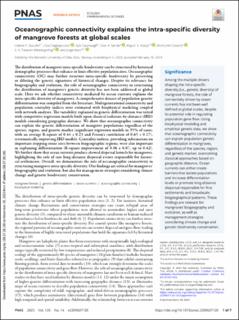| dc.contributor.author | Gouvêa, Lidiane P. | |
| dc.contributor.author | Fragkopoulou, Eliza | |
| dc.contributor.author | Cavanaugh, Kyle | |
| dc.contributor.author | Serrão, Ester A. | |
| dc.contributor.author | Araújo, Miguel B. | |
| dc.contributor.author | Costello, Mark John | |
| dc.contributor.author | Westergerling, Eugenie Heliana Taraneh | |
| dc.contributor.author | Assis, Jorge | |
| dc.date.accessioned | 2023-12-05T14:04:10Z | |
| dc.date.available | 2023-12-05T14:04:10Z | |
| dc.date.created | 2023-05-09T14:33:41Z | |
| dc.date.issued | 2023 | |
| dc.identifier.citation | Proceedings of the National Academy of Sciences of the United States of America. 2023, 120 (14), . | |
| dc.identifier.issn | 0027-8424 | |
| dc.identifier.uri | https://hdl.handle.net/11250/3106083 | |
| dc.description.abstract | The distribution of mangrove intra-specific biodiversity can be structured by historical demographic processes that enhance or limit effective population sizes. Oceanographic connectivity (OC) may further structure intra-specific biodiversity by preserving or diluting the genetic signatures of historical changes. Despite its relevance for biogeography and evolution, the role of oceanographic connectivity in structuring the distribution of mangrove’s genetic diversity has not been addressed at global scale. Here we ask whether connectivity mediated by ocean currents explains the intra-specific diversity of mangroves. A comprehensive dataset of population genetic differentiation was compiled from the literature. Multigenerational connectivity and population centrality indices were estimated with biophysical modeling coupled with network analyses. The variability explained in genetic differentiation was tested with competitive regression models built upon classical isolation-by-distance (IBD) models considering geographic distance. We show that oceanographic connectivity can explain the genetic differentiation of mangrove populations regardless of the species, region, and genetic marker (significant regression models in 95% of cases, with an average R-square of 0.44 ± 0.23 and Person’s correlation of 0.65 ± 0.17), systematically improving IBD models. Centrality indices, providing information on important stepping-stone sites between biogeographic regions, were also important in explaining differentiation (R-square improvement of 0.06 ± 0.07, up to 0.42). We further show that ocean currents produce skewed dispersal kernels for mangroves, highlighting the role of rare long-distance dispersal events responsible for historical settlements. Overall, we demonstrate the role of oceanographic connectivity in structuring mangrove intra-specific diversity. Our findings are critical for mangroves’ biogeography and evolution, but also for management strategies considering climate change and genetic biodiversity conservation. | |
| dc.language.iso | eng | |
| dc.title | Oceanographic connectivity explains the intra-specific diversity of mangrove forests at global scales | |
| dc.title.alternative | Oceanographic connectivity explains the intra-specific diversity of mangrove forests at global scales | |
| dc.type | Peer reviewed | |
| dc.type | Journal article | |
| dc.description.version | publishedVersion | |
| dc.source.pagenumber | 7 | |
| dc.source.volume | 120 | |
| dc.source.journal | Proceedings of the National Academy of Sciences of the United States of America | |
| dc.source.issue | 14 | |
| dc.identifier.doi | 10.1073/pnas.2209637120 | |
| dc.identifier.cristin | 2146495 | |
| cristin.ispublished | true | |
| cristin.fulltext | original | |
| cristin.qualitycode | 2 | |
